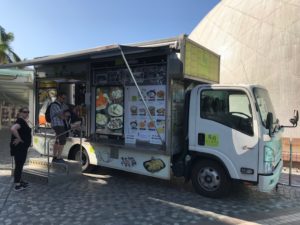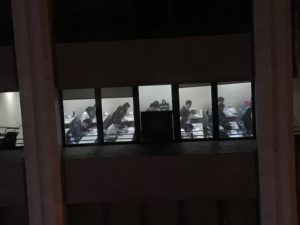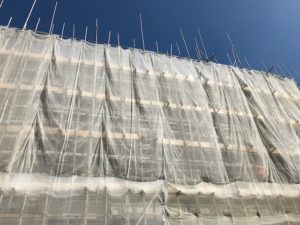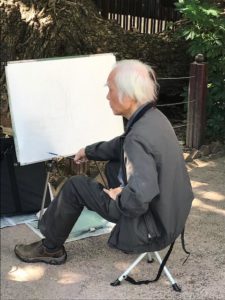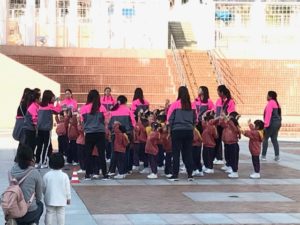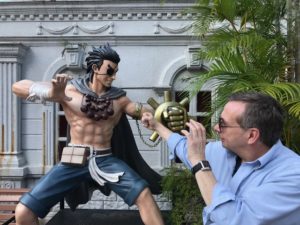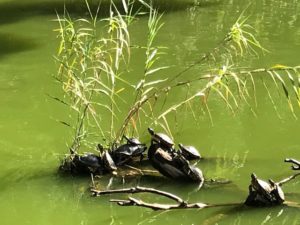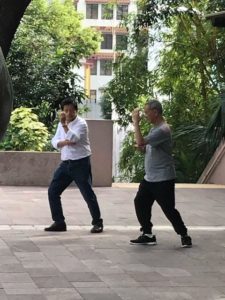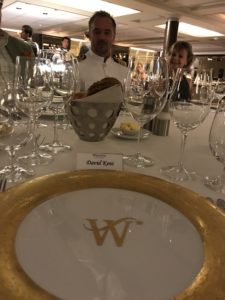 One of the many thrills from my most recent Windstar cruise was dinner with the Captain. Given that the Captain’s table – a large oval in the center of the dining room – seemed to sit empty throughout the cruise, the event was very special indeed.
One of the many thrills from my most recent Windstar cruise was dinner with the Captain. Given that the Captain’s table – a large oval in the center of the dining room – seemed to sit empty throughout the cruise, the event was very special indeed.
By this time Ru and I had been on the Star Legend, one of Windstar’s three powered yachts and sister to the Star Breeze we took in the summer, for most of the two week cruise through the Philippines, Malaysia, and Brunei. It had been a busy day. An “at sea” day, I spent several hours in the bow Yacht Club writing about 2400 words of my new “historical science fiction” novel, which I had started earlier on the trip since I couldn’t lug all the research materials for my non-fiction Lincoln book. I also caught up on some long behind reading, which helped me reach my reading challenge goal for the year.
At lunchtime the ship offered Asian-style poke bowls on deck. Later we attended a cocktail party for yacht club members, who are people that have taken more than one Windstar cruise. This was our third cruise, and second one in 5 months, so we enjoyed complimentary wine and gourmet canapes while chatting with the other guests and crew. As we entered, the captain held the door for us. We would see him again shortly.
Captain Remi Eriksen met us outside the dining room and escorted us to the center table. Besides Ru and I, we were joined by a quartet from Melbourne, Australia and a couple from Ontario, Canada. We had been in Melbourne a year before so much of the discussion leaned in that direction for a while, then into Canada and general travel. And of course, Captain Eriksen regaled us with stories from the ship. A native of Norway but now living in Spain, Eriksen had only been captain of the Star Legend for two and half months. Prior to our boarding in Honk Kong, the Star Legend had encountered a typhoon off the coast of Vietnam. After we got off in Singapore there was a tsunami along the coast of Indonesia, where the Star Legend was headed. He certainly earned his captain’s bars.
Normally we would have a single glass of wine with dinner each night, but the waiters repeatedly swooped in to refill our glasses before they were empty. One of the benefits of dining with the captain, I thought, as I walked gingerly from the room.
It was a delightful evening and I gained an even greater appreciation for the great work the crew and staff of the ship do to keep the 200 passengers happy. So thank you Captain Eriksen and Windstar for a wonderful trip.
After we landed in Singapore, Ru and I realized that this was our third Windstar cruise, and all three had been on different ships. Our first was on the flagship, Wind Surf, a five-mast sailing ship for which the nightly “Sail Away” is especially heartwarming as the sails are raised to the sounds of Vangelis playing on the upper deck. We also realized that the three ships had gone to three different parts of the world – Caribbean (Wind Surf), Baltic Sea in northern Europe/Russia (Star Breeze), and Hong Kong/Philippines/Malaysia/Brunei/Singapore in the South China Sea (Star Legend). Windstar has a total of six ships, the three remaining include one more sister yacht to the Star Legend/Breeze, plus a pair of slightly smaller sailing ships. We’ve informally decided to plan our travel so we can cruise on all six of the Windstar fleet, and to six different parts of the world. Hey, you have to set goals.
We haven’t booked our next Windstar cruise yet but we have a few places in mind. Until then, bon voyage!
David J. Kent is an avid science traveler and the author of Lincoln: The Man Who Saved America, in Barnes and Noble stores now. His previous books include Tesla: The Wizard of Electricity and Edison: The Inventor of the Modern World and two e-books: Nikola Tesla: Renewable Energy Ahead of Its Time and Abraham Lincoln and Nikola Tesla: Connected by Fate.
Check out my Goodreads author page. While you’re at it, “Like” my Facebook author page for more updates!





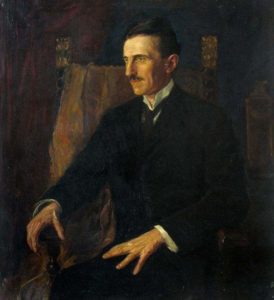 During his illustrious scientific career, Nikola Tesla developed many inventions that changed the world, including his unique design for a rotating magnetic field motor that enabled the use of alternating current on a commercial basis, wireless communication across vast distances, and even early “shadowgraphs,” precursors to X-rays. He also made forays into areas that, while he did not succeed in commercializing, set the stage for future developments, including wireless remote control of boats and other devices (robotics). Tesla did make some grandiose claims that did not come to fruition, the biggest of which included the wireless transmission of power through the Earth, plus a directed energy weapon. He also claimed to have communicated with intelligent beings from the planet Venus or Mars.
During his illustrious scientific career, Nikola Tesla developed many inventions that changed the world, including his unique design for a rotating magnetic field motor that enabled the use of alternating current on a commercial basis, wireless communication across vast distances, and even early “shadowgraphs,” precursors to X-rays. He also made forays into areas that, while he did not succeed in commercializing, set the stage for future developments, including wireless remote control of boats and other devices (robotics). Tesla did make some grandiose claims that did not come to fruition, the biggest of which included the wireless transmission of power through the Earth, plus a directed energy weapon. He also claimed to have communicated with intelligent beings from the planet Venus or Mars.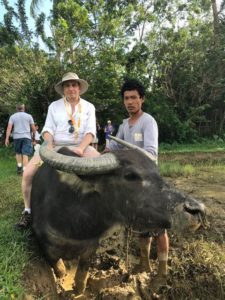 I was traveling. That’s my excuse for being a bit tardy on this wrap of the year in science traveling, 2018. And what a year of traveling it was, with 8 new countries visited, plus a lot of domestic travel. Click on the links for stories about some of the stops.
I was traveling. That’s my excuse for being a bit tardy on this wrap of the year in science traveling, 2018. And what a year of traveling it was, with 8 new countries visited, plus a lot of domestic travel. Click on the links for stories about some of the stops.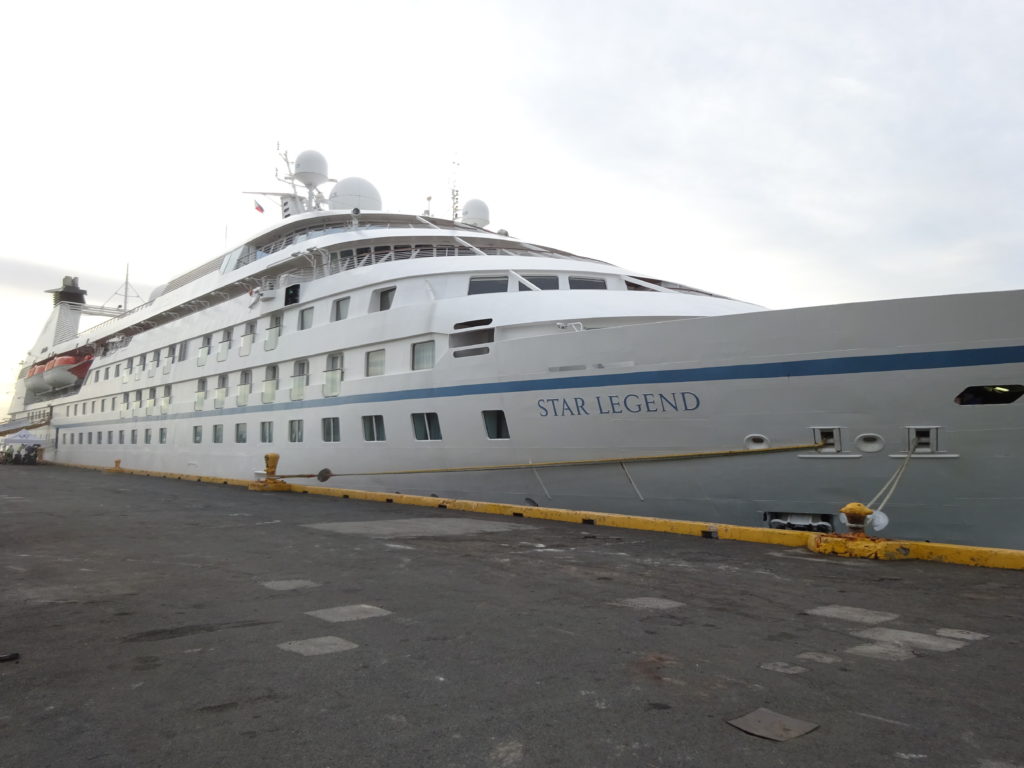 The end of June put me on a
The end of June put me on a  Three days later we flew out to
Three days later we flew out to 

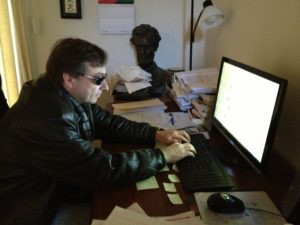 The year 2018 in a writer’s life was good. Well, kind of up and down, really. Okay, let’s just call it a year of transition. And that is actually a good thing.
The year 2018 in a writer’s life was good. Well, kind of up and down, really. Okay, let’s just call it a year of transition. And that is actually a good thing.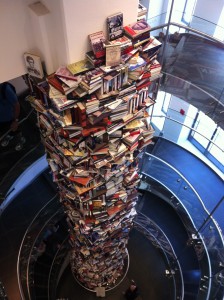 My Abraham Lincoln book collection continues to grow, quickly filling the new library space I created last year. I acquired 69 new Lincoln books in 2018. This compares to 59 in
My Abraham Lincoln book collection continues to grow, quickly filling the new library space I created last year. I acquired 69 new Lincoln books in 2018. This compares to 59 in 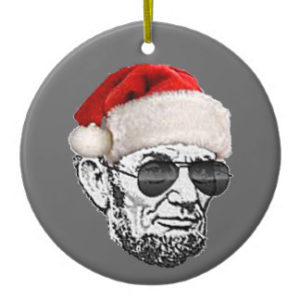 A few days before Christmas 1864, Abraham Lincoln received a Christmas present from General William T. Sherman –
A few days before Christmas 1864, Abraham Lincoln received a Christmas present from General William T. Sherman – 




























